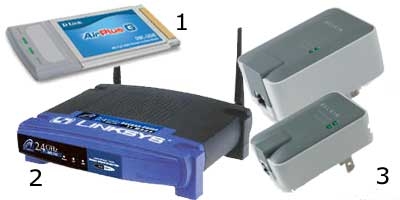Building Your Home Network Page 3
A Sample NetworkEvery network is different, of course, but the illustration above covers many of the issues you're likely to encounter as you put together or expand your home network.  1. D-link AirPlus G Wi-Fi (802.11g) adapter for laptops ($49). 2. Linksys WAP11 Wi-Fi access point ($69). 3. Belkin Ethernet and USB Powerline adapters ($100 each).
1. D-link AirPlus G Wi-Fi (802.11g) adapter for laptops ($49). 2. Linksys WAP11 Wi-Fi access point ($69). 3. Belkin Ethernet and USB Powerline adapters ($100 each).
This family's cable modem is located in the den, where the main cable feed enters. Cat-5 cable (red) connects the modem to the Fast Ethernet router, which breaks the network into three legs to extend it to other parts of the house. (Some installations use a combination modem and router called a residential gateway.)
The first leg goes via Cat-5 cable to a hub to which a PC and printer in the home office are connected. The second leg goes via Cat-5 cable to a HomePlug Ethernet-to-powerline bridge, which allows the network to be extended over the home's electrical wiring (blue) to anywhere a HomePlug Powerline adapter is plugged into an electrical outlet. Anything connected to the HomePlug network - like the "Internet appliance" in the kitchen - is limited to a maximum data rate of 14 Mbps, which is more than adequate for the Web browsing the countertop device is designed for.
The third leg is connected to an 802.11g wireless access point, with its maximum data rate of 54 Mbps, so that other devices can connect to the wired network wirelessly. For example, the home theater gear is linked to the access point in the den via a Wi-Fi bridge. Since the bridge and access point are close enough to maintain a high data rate, there shouldn't be any problem streaming music and displaying images from the den's PC through the DVD player/media receiver. The music server similarly has no trouble connecting to Gracenote's online CDDB database to get album and track information.
Like the kitchen, the kid's room is linked to the network via the electrical lines. The connection from the HomePlug Powerline adapter is more than fast enough for Internet gaming on the Xbox, or for using the Media Center PC for Web browsing or downloading TV program guide data. Also connected to the kid's room hub is another wireless access point that fills in dead spots that are too far from the den's access point. Without it, the PDA in the kitchen would not be able to connect reliably. Although the kid's room has an 802.11g access point, the PDA connecting to the network is limited to 14 Mbps because of the HomePlug Powerline adapter used to connect this access point to the network.
In the master bedroom, an Internet boombox is used to stream audio from the PCs on the network and also to listen to Internet radio. The laptop connects to the main access point in the den via its 802.11b PCCard adapter, so it's limited to 11 Mbps.
The beauty of building a home network is that it's not an all-in-one proposition. You can start small - say, by using a media receiver to stream audio from your PC to your main stereo gear - and add things as you go. Since you can't really hurt anything, don't be afraid to experiment. The best way to learn is by doing. And you never know when you'll need some small talk to break an awkward silence at your in-laws' next dinner party.
- Log in or register to post comments



































































